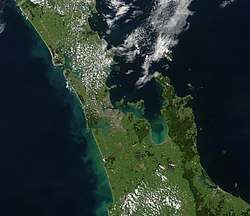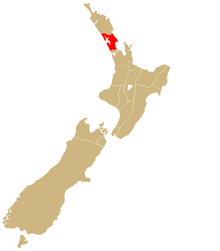Ngāti Whātua
Ngāti Whātua is a Māori iwi (tribe) of the lower Northland Peninsula of New Zealand's North Island.[1] It comprises a confederation of four hapū (subtribes) interconnected both by ancestry and by association over time: Te Uri-o-Hau, Te Roroa, Te Taoū, and Ngāti Whātua-o-Ōrākei.[2] The four hapū can act together or separately as independent tribes.[3]
| Ngāti Whātua | |
|---|---|
| Iwi (tribe) in Māoridom | |
 Lower Northland Peninsula | |
 | |
| Rohe (region) | Northland and Auckland |
| Waka (canoe) | Māhuhu-ki-te-rangi |
| Website | www |
Ngāti Whātua's territory or rohe is traditionally expressed as, "Tāmaki ki Maunganui i te Tai Hauauru" and "Tāmaki ki Manaia i te Rawhiti". The northern boundary is expressed as, "Manaia titiro ki Whatitiri, Whatitiri titiro ki Tutamoe, Tutamoe titiro ki Maunganui". The southern boundary is expressed as, "Te awa o Tāmaki". The area runs from Tāmaki River in the south to Maunganui Bluff (at the northern end of Aranga Beach on the west coast) in the north, and to Whangarei Harbour on the east coast. By the time of European settlement in New Zealand, Ngāti Whātua's territory was around the Kaipara Harbour and stretching south to Tāmaki Makaurau, the site of present-day Auckland.[2]
History
Ngāti Whātua descends from the ancestor Tuputupuwhenua (also known as Tumutumuwhenua). The iwi traces its arrival in New Zealand to the Māhuhu-ki-te-rangi canoe, which landed north of the Kaipara Harbour. They also descend from ancestors who migrated from Muriwhenua in the Far North and intermarried with the tribes in Ngāti Whātua's territory.[3]
Rivalry with Ngāpuhi escalated in the early 19th century when Ngāpuhi acquired muskets. Ngāpuhi attacked Ngāti Whātua in 1807 or 1808 in the battle of Moremonui north of Dargaville - probably the occasion of the first use of firearms in Māori warfare. Ngāti Whātua overcame the Ngāpuhi warriors with hand weapons while Ngāpuhi were reloading their muskets, winning a decisive victory over the attackers. Ngāpuhi, led by Hongi Hika, exacted revenge in 1825 when they defeated Ngāti Whātua in the battle of Te Ika a Ranganui near Kaiwaka.
On 20 March 1840 in the Manukau Harbour area where Ngāti Whātua farmed, paramount chief Āpihai Te Kawau signed Te Tiriti o Waitangi, the Treaty of Waitangi.[4] Ngāti Whātua sought British protection from Ngāpuhi as well as a reciprocal relationship with the Crown and the Church. Soon after signing the Treaty, Te Kawau offered land on the Waitematā Harbour to William Hobson, the new Governor of New Zealand, for his new capital.[5][6][7][8] Hobson took up the offer and moved the capital of New Zealand to Tāmaki Makaurau, naming the settlement Auckland.
Ngāti Whātua came to national prominence in the 1970s in a dispute over vacant land at Bastion Point, a little way east of the Auckland city centre, adjoining the suburb of Orakei. The land, which the New Zealand government had acquired cheaply for public works many decades before, largely reverted to the tribe after a long occupation and passive resistance.[9][10]
Governance
Te Runanga o Ngāti Whātua has a mandate, recognised by the New Zealand Government, to negotiate Treaty of Waitangi settlements for Ngāti Whatua. It is also a mandated iwi organisation under the Māori Fisheries Act, and an Iwi Aquaculture Organisation in the Māori Commercial Aquaculture Claims Settlement Act. It represents Ngāti Whatua as an iwi authority under the Resource Management Act and is a Tūhono organisation.
The Runanga is a Māori Trust Board governed by 11 trustees from 5 takiwā or districts: 1 trustee from Ōrakei, 2 from South Kaipara, 3 from Otamatea, 1 from Whangarei and 4 from Northern Wairoa.[1] As of 2016, the chairperson of the trust is Russell Kemp, the support services manager is Pat Murray, and the trust is based in Whangarei.[11]
The iwi has interest in the territory of Northland Regional Council, Auckland Council, Kaipara District Council and Whangarei District Council.[1]
Hapū and marae
Northern Wairoa
- Ngāti Hinga hapu, based at Ahikiwi marae (Te Aranga Mai o te Whakapono wharenui), Kaihū
- Ngāti Torehina, based at Taita marae (Kia Mahara Koutou wharenui), Māmaranui
- Unidentified hapu, based at Kāpehu marae (Tāringaroa wharenui), Mititai, and Tama te Uaua marae (Tama te Uaua wharenui), Kaihū
- Te Kuihi, based at Te Houhanga marae (Rāhiri wharenui), Dargaville
- Te Popoto, based at Ōtūrei marae (Rangimārie Te Aroha wharenui), Aratapu
- Te Roroa, based at Pananawe marae (Te Taumata o Tiopira Kinaki wharenui), Waipoua; Te Houhanga marae (Rāhiri wharenui), Dargaville; Waikarā marae (Te Uaua wharenui), Aranga; Waikaraka marae (Whakarongo wharenui), Kaihū
- Te Uri o Hau, based at: Naumai marae (Ngā Uri o te Kotahitanga wharenui), Ruawai; Ōtūrei marae (Rangimārie Te Aroha wharenui), Aratapu; Rīpia marae (No wharenui), Rīpia, and Pouto; Waikaretu marae, Matakohe; Parirau Marae-Wharemarama (Te Uri-o-Hau). [1]
Whangarei
The Whangarei district has four hapu (sub-tribes):
- Patuharakeke hapu, based at Takahiwai marae (Rangiora wharenui), Takahiwai
- Te Kuihi hapu, based at Tangiterōria marae (Tirarau wharenui), Tangiterōria
- Te Parawhau hapu, based at Korokota marae (Tikitiki o Rangi wharenui), Tītoki and Tangiterōria marae (Tirarau wharenui), Tangiterōria
- Te Uriroroi hapu, based at Toetoe mare (Toetoe wharenui), Ōtaika[1]
Orakei
- Ngā Oho, based at Ōrākei marae (with Tumutumuwhenua wharenui), Ōrākei
- Te Taoū, based at Ōrākei marae (with Tumutumuwhenua wharenui), Ōrākei
- Te Uri Ngutu, based at Ōrākei marae (with Tumutumuwhenua wharenui), Ōrākei[1]
Radio station
Ake 1179 is the official radio station of Ngāti Whātua, but is not officially part of the iwi radio network.[12] It broadcasts on 1179 AM in Auckland, and features a combination of urban contemporary music and traditional storytelling.[13]
Notable people
- Naida Glavish, politician and community leader
- Joe Hawke, politician and businessman
- Josh Hohneck, rugby union player
- Hugh Kāwharu, chief and academic
- Merata Kawharu, writer and academic
- Graham Latimer, former Māori Council president
- Manos Nathan, ceramicist
- Paraire Karaka Paikea, politician and church minister
- Otene Paora, Māori leader and land negotiator
- Tame Te Rangi, civil servant and sports commentator
- Ngapipi Reweti, land negotiator
- Āpihai Te Kawau, tribal leader
- Pāora Tūhaere, tribal leader
References
- "Rohe". tkm.govt.nz. Te Puni Kōkiri, New Zealand Government. Retrieved 2 March 2016.
- "Te rohe o Ngāti Whātua: our area". Te Rūnanga o Ngāti Whātua. Archived from the original on 24 May 2015. Retrieved 24 May 2015.
- Taonui, Rāwiri (22 September 2012). "Ngāti Whātua - Origins". Te Ara – the Encyclopedia of New Zealand. Retrieved 24 May 2015.
- "Signing the Treaty in Manukau in 1840". Auckland Council. Archived from the original on 4 June 2016. Retrieved 24 May 2016.
- Pihema, Ani; Kerei, Ruby; Oliver, Steven. "Apihai Te Kawau". Dictionary of New Zealand Biography. Ministry for Culture and Heritage. Retrieved 23 April 2017.CS1 maint: uses authors parameter (link)
- "Āpihai Te Kawau". Research and Publishing Group of the New Zealand Ministry for Culture and Heritage. Retrieved 3 August 2019.
- "Apihai Te Kawau". Ngāti Whātua-o-Ōrākei. Retrieved 11 August 2019.
- "Cultural Values Assessment in Support of the Notices of Requirement for the Proposed City Rail Link Project" (PDF). Auckland Transport. Retrieved 11 August 2019.
- "Bastion Point - The Untold Story" (Documentary). nzonscreen.com. NZ On Screen. 1999. Retrieved 16 September 2016.
- Royal, Te Ahukaramū Charles Royal (11 July 2013). "Police cordon, Bastion Point". Te Ara – the Encyclopedia of New Zealand. Retrieved 24 May 2015.
- "Ngati Whatua". ngatiwhatua.iwi.nz. Ngāti Whatua. Retrieved 16 September 2016.
- "Listen Online". Irirangi. Te Whakaruruhau o Nga Reo Irirangi Māori. Retrieved 28 April 2015.
- {{cite web|title=Ake 1179 |url= http://www.ngatiwhatua.iwi.nz/manaakitanga/ake-1179am%7Cwebsite=Te Rūnanga Ngāti Whātua|publisher=Ngāti Whātua|accessdate=14 June 2015} Archived 22 January 2016 at the Wayback Machine}
External links
- Te Rūnanga o Ngāti Whātua
- Ngāti Whātua, Te Ara – the Encyclopedia of New Zealand
- Orakei resource kit, Waitangi Tribunal